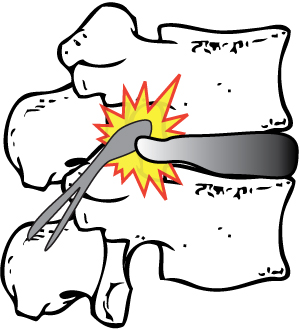
Overview - The spine has disks between the vertebrae that act like shock absorbers. The inside of the disc contains a jelly like substance called the nucleus. Surrounding the nucleus is a dense outer layer called the annulus. A disk hernia occurs when the annulus is torn and the nucleus pushes out through the tear. Large nerves that exit the spine called "nerve roots" can be compressed or irritated by a disc hernia. The resulting symptoms often include travelling pain (radiculopathy) down one leg. This is often referred to as sciatica.
*Herniated discs are also referred to as: slipped disc, disc bulge, sequestration, disc injury, disc lesion
Symptoms
- Low back pain - 98% of all lumbar disc herniations occur at L4-L5 and L5-S1 which is at the base of the back.
- Sciatic type pain that travels into the buttocks and down the thigh/leg into the calf/foot, is common. Depending on what nerve is affected, the pain can also travel down the front of the thigh and into the groin. Sharp shooting and burning pain are also common.
- Numbness and tingling - patients often report patches of skin that have lost all feeling
- Loss of strength - foot drop, difficulty climbing stairs
- Diminished reflexes
Cause - Disk herniation is most often the result of a gradual, aging-related wear and tear called disk degeneration. As people age, the disks become less flexible and more prone to tearing or rupturing with even a minor strain or twist. Alternatively, heavy trauma can also cause a disc to suddenly rupture.
* Repetative bending and twisting should be avoided during exercise and work. Discs are particularly open to injury when heavy loading is coupled with twisting.
Treatment options
- Spinal decompression, flexion/distraction, spinal manipulative therpy
- Prescribed exercises and home/work ergonomic advice
- Therapy modalities, ice
- Medication
- Surgery

